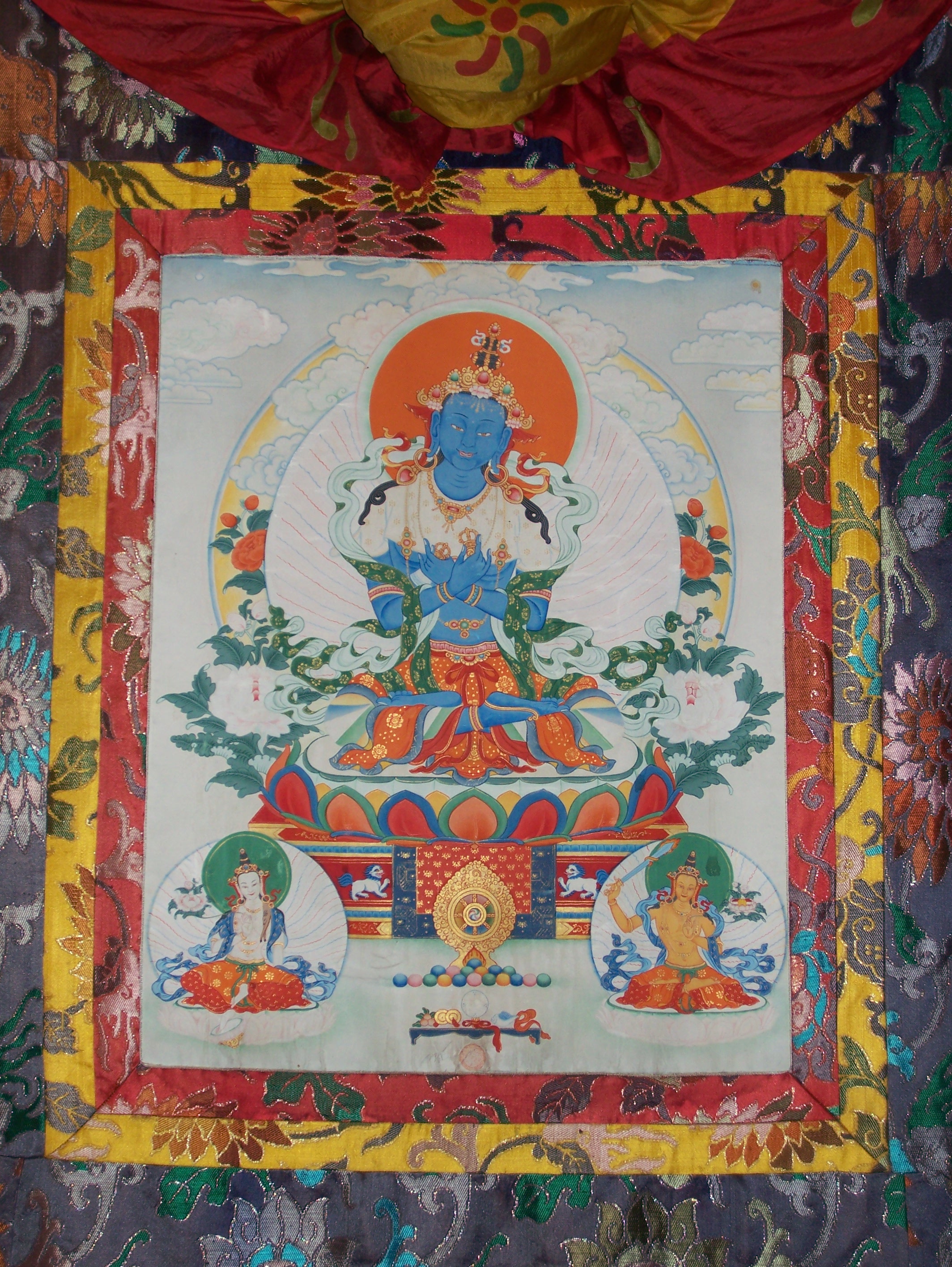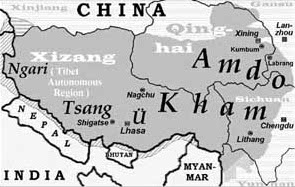|
Shangpa Kagyu
The Shangpa Kagyu (, "Oral Tradition of the man from Shang") is known as the "secret lineage" of the Kagyu school of Vajrayana or Tibetan Buddhism and differs in origin from the better known Dagpo Kagyu schools. The Dagpo Kagyu are the lineage of Tilopa through his student Naropa, often traced through Naropa's famous student Marpa Lotsawa and thus called "Marpa Kagyu", while the Shangpa lineage descends from Tilopa's student Niguma, who was Naropa's sister, as well as from the teachings of Sukhasiddhi. Its founder was Khyungpo Naljor, the student of both women, whose monastery in the Shang Valley gave its name to the tradition. The principal Shangpa dharmapala is the six-armed Mahākāla. The Shangpa tradition was revitalized in the 20th century by the first Kalu Rinpoche, who had many students both in Tibet and in the West. Origins The Shangpa Kagyu lineage was founded by the eleventh-century Tibetan scholar Khyungpo Naljor. Seeking to increase his understanding of th ... [...More Info...] [...Related Items...] OR: [Wikipedia] [Google] [Baidu] |
Mahamudra
Mahāmudrā (Sanskrit: महामुद्रा, , contraction of ) literally means "great seal" or "great imprint" and refers to the fact that "all phenomena inevitably are stamped by the fact of wisdom and emptiness inseparable". Mahāmudrā is a multivalent term of great importance in later Indian Buddhism and Tibetan Buddhism which "also occurs occasionally in Hindu and East Asian Buddhist esotericism." The name also refers to a body of teachings representing the culmination of all the practices of the Sarma schools of Tibetan Buddhism, who believe it to be the quintessential message of all of their sacred texts. The ''mudra'' portion denotes that in an adept's experience of reality, each phenomenon appears vividly, and the ''maha'' portion refers to the fact that it is beyond concept, imagination, and projection.Reginald Ray, ''Secret of the Vajra World''. Shambhala 2001, page 261. The practice of Mahāmudrā is also known as the teaching called "Sahajayoga" or "Co-eme ... [...More Info...] [...Related Items...] OR: [Wikipedia] [Google] [Baidu] |
Gelug
file:DalaiLama0054 tiny.jpg, 240px, 14th Dalai Lama, The 14th Dalai Lama (center), the most influential figure of the contemporary Gelug tradition, at the 2003 Kalachakra ceremony, Bodh Gaya, Bodhgaya (India). The Gelug (, also Geluk; "virtuous")Kay, David N. (2007). ''Tibetan and Zen Buddhism in Britain: Transplantation, Development and Adaptation,'' p. 39. Routledge. is the newest of the four major schools of Tibetan Buddhism. It was founded by Je Tsongkhapa (1357–1419), a Tibetan people, Tibetan philosopher, Vajrayana, tantric yogi and lama and further expanded and developed by his disciples (such as Khedrup Gelek Pelzang, 1st Panchen Lama, Khedrup Je, Gyaltsab Je, Gyaltsap Je and 1st Dalai Lama, Gendün Drubpa). The Gelug school is alternatively known as New Kadam (''bKa’-gdams gsar-pa''), since it sees itself as a continuation of the Kadam (Tibetan Buddhism), Kadam tradition of Atiśa, Atisha (c. 11th century). Furthermore, it is also called the Ganden Monastery, Ganden ... [...More Info...] [...Related Items...] OR: [Wikipedia] [Google] [Baidu] |
Je Tsongkhapa
Tsongkhapa ('','' meaning: "the man from Tsongkha" or "the Man from Onion Valley", c. 1357–1419) was an influential Tibetan Buddhist monk, philosopher and tantric yogi, whose activities led to the formation of the Gelug school of Tibetan Buddhism.Tsong khapa (2006), pp. ix-x. He is also known by his ordained name Losang Drakpa (, Skt. Sumatikīrti) or simply as "Je Rinpoche" (, "Precious Lord"). He is also known by Chinese as Zongkapa Lobsang Zhaba or just Zōngkàbā (宗喀巴). Tsongkhapa was born in Amdo, the son of a Tibetan Longben Tribal leader who also once served as an official of the Yuan Dynasty. As a monk, he studied under numerous teachers of the various Tibetan Buddhist traditions which flourished in central Tibet, including Sakya, Jonang, Kagyu and Kadam. Tsongkhapa was a prolific author with a broad knowledge of Buddhist philosophy, logic, hermeneutics and practice. He wrote numerous works on madhyamaka philosophy (such as ''Ocean of Reasoning,'' a comment ... [...More Info...] [...Related Items...] OR: [Wikipedia] [Google] [Baidu] |
Sakya (Tibetan Buddhist School)
The ''Sakya'' (, 'pale earth') school is one of four major schools of Tibetan Buddhism, the others being the Nyingma, Kagyu, and Gelug. It is one of the Red Hat Orders along with the Nyingma and Kagyu. Origins Virūpa, 16th century. It depicts a famous episode in his hagiography when he stopped the sun in the sky. The name ''Sakya'' ("pale earth") derives from the unique grey landscape of the Ponpori Hills in southern Tibet near Shigatse, where Sakya Monastery, the first monastery of this tradition, and the seat of the Sakya School was built by Khon Konchog Gyalpo (1034–1102) in 1073. The Sakya tradition developed during the second period of translation of Buddhist scripture from Sanskrit into Tibetan in the late 11th century. It was founded by Drogmi, a famous scholar and translator who had studied at the Vikramashila directly under Naropa, Ratnākaraśānti, Vagishvakirti and other great panditas from India for twelve years. Khon Konchog Gyalpo became Drogmi's disc ... [...More Info...] [...Related Items...] OR: [Wikipedia] [Google] [Baidu] |
Jamgon Kongtrul
Jamgön Kongtrül Lodrö Thayé (, 1813–1899), also known as Jamgön Kongtrül the Great, was a Tibetan Buddhist scholar, poet, artist, physician, tertön and polymath.Jackson, Roger R. The Tibetan Leonardo, 2012, https://www.lionsroar.com/the-tibetan-leonardo/ He was one of the most prominent Tibetan Buddhists of the 19th century and he is credited as one of the founders of the Rimé movement (non-sectarian), compiling what is known as the "Five Great Treasuries".Jamgon Kongtrul, Kalu Rinpoche translation group, The Treasury of Knowledge: Book One: Myriad Worlds, Translators' Introduction. He achieved great renown as a scholar and writer, especially among the Nyingma and Kagyu lineages and composed over 90 volumes of Buddhist writing, including his magnum opus, '' The Treasury of Knowledge''. Overview Kongtrül was born in Rongyab (rong rgyab), Kham, then part of the Derge Kingdom.Alexander Gardner, "Jamgon Kongtrul Lodro Taye," Treasury of Lives, accessed May 18, 2018, ht ... [...More Info...] [...Related Items...] OR: [Wikipedia] [Google] [Baidu] |
Vajradhara
Vajradhara (Sanskrit: वज्रधर. (Also, the name of Indra, because 'Vajra' means diamond, as well as the thunderbolt, anything hard more generally) Tibetan: རྡོ་རྗེ་འཆང། rdo rje 'chang (Dorje Chang); zh, t=金剛總持, p=Jīngāng zǒng chí; Javanese: Kabajradharan; Japanese: 持金剛仏; English: Diamond-holder; Vietnamese: Kim Cang Tổng Trì) is the ultimate primordial Buddha, or Adi-Buddha, according to the Sakya, Gelug and Kagyu schools of Tibetan Buddhism. In the evolution of Indian Buddhism, Buddha Vajradhara gradually displaced Samantabhadra, who is the 'Primordial Buddha' in the Nyingma, or 'Ancient School.' However, the two are metaphysically equivalent. Achieving the 'state of Vajradhara' is synonymous with complete realisation. According to the Kagyu lineage, Buddhā Vajradhara is the primordial Buddha, the Dharmakaya Buddha. He is depicted as dark blue in color, expressing the quintessence of buddhahood itself and representing ... [...More Info...] [...Related Items...] OR: [Wikipedia] [Google] [Baidu] |
Ü-Tsang
Ü-Tsang is one of the three traditional provinces of Tibet, the others being Amdo in the north-east, and Kham in the east. Ngari (including former Guge kingdom) in the north-west was incorporated into Ü-Tsang. Geographically Ü-Tsang covered the south-central of the Tibetan cultural area, including the Brahmaputra River watershed. The western districts surrounding and extending past Mount Kailash are included in Ngari, and much of the vast Changtang plateau to the north. The Himalayas defined Ü-Tsang's southern border. The present Tibet Autonomous Region corresponds approximately to what was ancient Ü-Tsang and western Kham. Ü-Tsang was formed by the merging of two earlier power centers: Ü () in central Tibet, controlled by the Gelug lineage of Tibetan Buddhism under the early Dalai Lamas, and Tsang () which extended from Gyantse to points west, controlled by the rival Sakya lineage. Military victories by the powerful Khoshut Mongol Güshi Khan that backed 5th Dalai ... [...More Info...] [...Related Items...] OR: [Wikipedia] [Google] [Baidu] |
Thang Tong Gyalpo
Thangtong Gyalpo () (1385 CE–1464 CE or 1361 CE–1485 CE), also known as Chakzampa, the "Iron Bridge Maker" (), Tsöndrü Zangpo "Excellent Persistence" (), and the King of the Empty Plain.Sarah Harding. Niguma, Lady of Illusion. Snow Lion Publications. 2010. p. 265, n. 84 He was also known by a variation of this name, Madman of the Empty Valley. He was a great Buddhist adept, a Chöd master, yogi, physician, blacksmith, architect, and a pioneering civil engineer. He is considered a mind emanation of Padmasambhava and a reincarnation of Dolpopa Sherab Gyaltsen. He founded the Iron Chain lineage of the Shangpa Kagyu school of Tibetan Buddhism, and he recognized the first Samding Dorje Phagmo, Chökyi Drönma (1422–1455), the female incarnation lineage of Vajravārāhī. Thangtong Gyalpo is said to have built 58 iron chain suspension bridges around Tibet and Bhutan, several of which are still in use today. He also designed and built several large stupas of unusual design ... [...More Info...] [...Related Items...] OR: [Wikipedia] [Google] [Baidu] |
Rāhula
, sa, Rāhula-bhadra; 2. , birth_date = , birth_place = Kapilavastu , death_date = , death_place = Sources differ , title = Patriarch of the Dharma (East Asian Buddhism) , predecessor = Āryadeva , successor = Sanghānandi , religion = Buddhism , location = , education = , rank = , teacher = Gautama Buddha, the Elder Śariputra , known_for = 1. pi, sikkhākāmanaṃ, italic=yes, lit=Eagerness for learning; 2. , initiation_date = 715 years in the Buddha's ministry , initiation_place = Park of Nigrodha , initiator = Śāriputra , parents = Prince Siddhārtha (father), Princess Yaśodharā (mother) , relatives = King Śuddhodana (grand father) Queen Māyā (grand mother) Suprabuddha (grand father) Amita (grand mother) Queen Mahāprajāpatī Gautamī (grand aunt) Sundarī Nandā(aunt) Nanda(uncle ... [...More Info...] [...Related Items...] OR: [Wikipedia] [Google] [Baidu] |
Maitripada
Maitrīpāda ( 1007–1085, also known as Maitreyanātha, Advayavajra, and, to Tibetans, Maitrīpa), was a prominent Indian Buddhist Mahasiddha associated with the Mahāmudrā transmission of tantric Buddhism.Roberts, Peter Alan, Mahamudra and Related Instructions: Core Teachings of the Kagyu Schools (Library of Tibetan Classics) 2011, p. 11-12. His teachers were Shavaripa and Naropa. His students include Atisha, Marpa, Vajrapani, Karopa, Natekara (also known as Sahajavajra), Devākaracandra (also known as Śūnyatāsamādhi), and Rāmapāla. His hermitage was in the Mithila region (also known as Tirhut), somewhere in northern Bihar and neighboring parts of southern Nepal. Early life As per Tibetan and Nepalese sources, Maitripada was born into a Brahmin family in Magadha in a village near Kapilavastu during the rule of the Pala empire. His year of birth has been commonly placed 1007 C.E. as per the writings of Taranatha who places him around the rule of King Mahipala. Prior ... [...More Info...] [...Related Items...] OR: [Wikipedia] [Google] [Baidu] |
Mahasiddha
Mahasiddha (Sanskrit: ''mahāsiddha'' "great adept; ) is a term for someone who embodies and cultivates the " siddhi of perfection". A siddha is an individual who, through the practice of sādhanā, attains the realization of siddhis, psychic and spiritual abilities and powers. Mahasiddhas were practitioners of yoga and tantra, or ''tantrika''s. Their historical influence throughout the Indian subcontinent and the Himalayas was vast and they reached mythic proportions as codified in their songs of realization and hagiographies, or namtars, many of which have been preserved in the Tibetan Buddhist canon. The Mahasiddhas are the founders of Vajrayana traditions and lineages such as Dzogchen and Mahamudra. Robert Thurman explains the symbiotic relationship between Tantric Buddhist communities and the Buddhist universities such as Nalanda which flourished at the same time. Genealogy and historical dates The exact genealogy and historical dates of the Mahasiddhas are contentiou ... [...More Info...] [...Related Items...] OR: [Wikipedia] [Google] [Baidu] |


.jpg)






